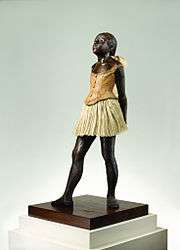Little Dancer of Fourteen Years

The Little Fourteen-Year-Old Dancer (French: La Petite Danseuse de Quatorze Ans) is a c. 1881 sculpture by Edgar Degas of a young student of the Paris Opera Ballet dance school, a Belgian named Marie van Goethem.
The sculpture is two-thirds life size and was originally sculpted in wax, an unusual choice of medium for the time. It is dressed in a real bodice, tutu and ballet slippers and has a wig of real hair. All but a hair ribbon and the tutu are covered in wax. The 28 bronze repetitions that appear in museums and galleries around the world today were cast after Degas' death. The tutus worn by the bronzes vary from museum to museum.
The exact relationship between Marie van Goethem and Edgar Degas is a matter of debate. It was common in 1880 for the "Petits Rats" of the Paris Opera to seek protectors from among the wealthy visitors at the back door of the opera.

When the La Petite Danseuse de Quatorze Ans was shown in Paris at the Sixth Impressionist Exhibition of 1881, it received mixed reviews. Joris-Karl Huysmans called it "the first truly modern attempt at sculpture I know'. Certain critics were shocked by the piece, and the dancer was compared to a monkey and an Aztec. One critic, Paul Mantz, called her the "flower of precocious depravity," with a face "marked by the hateful promise of every vice" and "bearing the signs of a profoundly heinous character."[1] Comparisons with older art were made, perhaps partly because it was exhibited in a glass case, like classical sculpture in the Louvre, and was dressed in wig and clothes.
The arms are taut, and the legs are quite twisted round, and there is tension in the pose, an image of a ballerina being put through her paces, not posing in an angelic way. Her face is – "contorted, people thought it was a deliberate image of ugliness, but you could also say it's the image of a sickly gawky adolesecent who is being made to do something she doesn't totally want to do."[2]
After Degas' death, his heirs (brother and sister's children[3]) made the decision to have the bronze repetitions of Le Petite Danseuse and other wax and mixed-media sculptures cast. The casting took place at the Hébrard foundry in Paris from 1920 until the mid-20th century. Sixty-nine of Degas's wax sculptures survived the casting process. One copy of Le Petite Danseuse is currently owned by the creator and owner of Auto Trader, John Madejski. He stated that he bought the sculpture by accident. That copy was sold for £13,257,250 ($19,077,250) at Sotheby's on February, 3rd 2009.[4] Another casting failed to sell at a November 2011 auction at Christie's.[5]
To construct the statue, Degas used a lead pipe armature[6] and, to some extent, paintbrushes for structural support.
The original wax sculpture was acquired by Paul Mellon in 1956. Beginning in 1985, Mr and Mrs Mellon gave the National Gallery of Art 49 Degas waxes, 10 bronzes and 2 plasters, the largest group of original Degas sculptures. Little Dancer was among the bequests. A version is also kept by the M.T. Abraham Center for the Visual Arts Foundation, and at times loaned out to other institutions.
Art historian Richard Kendall published a scholarly account of the history of Degas's sculpture, Degas and the Little Dancer, with contributions by Douglas Druick and Arthur Beale.[7] The BBC Two documentary The Private Life of a Masterpiece: Little Dancer Aged Fourteen, produced in 2004, closely examines the sculpture, the model, the circumstances of her life, and the critical reaction to the work. Cathy Marie Buchanan's novel, The Painted Girls, presents a fictionalised account of the life of Marie van Goethem, the model for the sculpture,[8] as does Carolyn Meyer's young adult novel Marie, Dancing[9] and Laurence Anholt's children's picture book Degas and the Little Dancer.[10] In 2014, the Kennedy Center for the Performing Arts in Washington, DC premiered the stage musical, "Little Dancer", inspired by the story of the young ballerina immortalized by Edgar Degas in his famous sculpture.
The piece inspired two of Damien Hirst's works, Virgin Mother and Verity.[11]
The sculpture is prominently featured in the 1993 thriller Malice.
References
- ↑ "Degas's Little Dancer is still on the point of controversy". 2011-11-02.
- ↑ Tim Marlow on... Degas, Sickert & Toulouse-Lautrec' Channel 5 TV
- ↑ "National Gallery of Art". 2011-11-02.
- ↑ "Auction results". 2009-02-04.
- ↑ "Degas Ballerina Fails to Sell at Christie's as Markets Plummet". 2011-11-02.
- ↑ "Unraveling the Mysteries of Degas's Sculpture". 2009-02-04.
- ↑ Kendall, Richard (1998). Degas and the Little Dancer. Yale university Press. ISBN 0-300-07497-2.
- ↑ "The Painted Girls". 2009-02-04.
- ↑ "Marie, Dancing". 2009-02-04.
- ↑ "Degas and the Little Dancer".
- ↑ Bond, Anthony (16 October 2012). "Thar she rises! Bump on the beach arrives as Damien Hirst's 65ft statue of a pregnant woman is hoisted upright in Iflracombe. But awesome or an eyesore?". Daily Mail. Retrieved 1 December 2014.
External links
| Wikimedia Commons has media related to La Petite Danseuse de Quatorze Ans. |
- "Little Dancer Musical Imagines The Story Behind Degas' Mysterious Muse" NPR
- The Little Fourteen–Year–Old Dancer sculpture at the Metropolitan Museum of Art.
- Little Dancer Aged Fourteen in the Tate Collection, London
- Little Dancer aged fourteen in the Robert and Lisa Sainsbury Collection.
- The Little Dancer, Aged Fourteen at the Hay Hill Gallery in London.
- "Degas's Little Dancer" at the National Gallery of Art.
- The Little Dancer of Fourteen Years at the M.T. Abraham Foundation
- Degas: The Artist's Mind, exhibition catalog from The Metropolitan Museum of Art fully available online as PDF, which contains material on Little Dancer of Fourteen Years (see index)
- "Little Dancer", The John F.Kennedy Center for the Performing Arts.